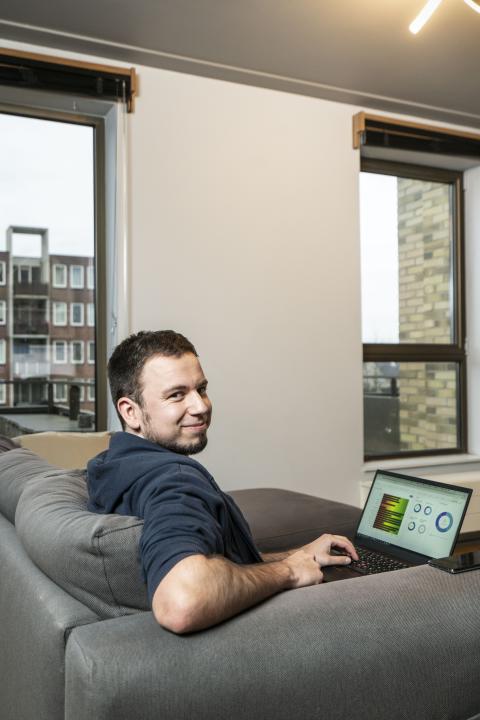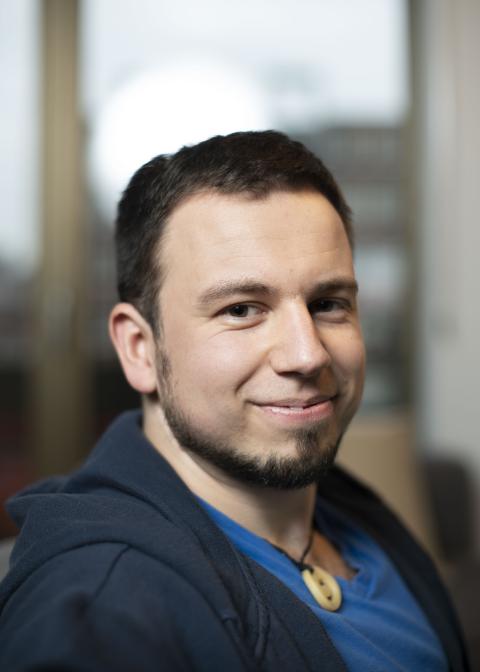From oddity to household name
Koen Peters spearheaded the OPTIMUS program, which is part of a digital revolution within the World Food Programme. The resulting savings have generated enough money to provide food for 2 million people for a year.
As an econometrics student, Koen Peters already knew that solving logistics problems would be in his future. But that he would cash in on his head for mathematics in the business world was something he doubted more and more with every class. “The focus was very often on the same kind of business examples: logistics, transport, investments, how to set up a pension system.... You learn to solve things like that using data and mathematics, but I didn’t find the topics all that exciting.” That’s why Peters looked outside the box for fields of work that were a little less obvious. At a conference on food insecurity, the penny dropped. “There, a former agriculture minister told us that there are 800 million people who don’t have enough to eat, even though there is enough food available worldwide. That sounded like the kind of problem I wanted to tackle: how do you get those products to the right place at the right time?”

Koen Peters (1991) received his master’s degree in operations research & management science from Tilburg University in 2014. He is now head of optimization at the World Food Programme and an external PhD student at the Zero Hunger Lab.
Thirty specialists
Within Tilburg University, Peters began looking for thesis options. This led him to Hein Fleuren, now director of the Zero Hunger Lab. With Fleuren’s help, he arranged a master’s internship with the UN World Food Programme (WFP). During his internship in 2014, Peters spearheaded the creation of the ingenious software program OPTIMUS, a model for assembling and distributing food packages that can handle every conceivable variable, requirement, and constraint. The model is part of an organization-wide digital revolution within the WFP, in close collaboration with the business community and tech-savvy universities like Tilburg. This has already led to a total savings of about $150 million for the organization – enough to provide 2 million people with enough food for a year. However, as a data researcher, Peters was still quite an oddity during his internship within the world of humanitarian aid. Together with just two colleagues, he faced the challenge of getting a prototype of OPTIMUS working for the supply chain of a WFP food program in Syria. Now, WFP has a team of thirty data specialists: the Supply Chain Planning & Optimization team.
It took several years to convince everyone in the organization of what you can do with data science and analytics
Step by step
The humanitarian world is used to working in very complex situations, under unpredictable conditions with an incredible number of variables. Think of, for example, natural disasters that result in acute emergencies, conflict situations that create danger and uncertainty, and areas that are sometimes inaccessible to road traffic for months on end during rainy seasons or after floods. Systems that have long since been implemented and optimized in the business world were inadequate for food aid organizations due to the complexity of humanitarian logistics, even though they operate on the same mathematical principles. In addition to speed and cost, it was necessary to factor in local conditions and nutritional values in logistics planning. When Peters flew to Jordan with the OPTIMUS prototype for Syria’s annual planning workshop, he was full of excitement about whether the mathematical puzzle that had been solved in theory would yield a working system. “I started talking to the local experts and looking at all the data. What are the characteristics to consider? What products can be included? What do they currently cost? That’s how I puzzled it all together in a mathematical model.” The model did what it promised to do, the team in Syria saved money to feed more mouths, and Peters was not allowed to leave WFP. “One of the key success factors was the pragmatic approach. In this field, we often see that data specialists approach the problem very theoretically or want to take all the exceptions into account right from the start. We built OPTIMUS step by step based on the data that was actually available to us.”
Long, bumpy road
By now, some seven years later, after an extensive testing phase and an even longer implementation phase, the model has evolved to the point where any employee in the chain without knowledge of mathematics can work with it easily. With a few clicks, you can see what the options are if, for example, you need to add products containing iron to a package within an operation or want to purchase more food from local entrepreneurs.
Peters has now well surpassed the programming stage. He mainly helps his colleagues worldwide with their data analytics questions. He is also the point of contact for other NGOs looking to optimize their humanitarian goals using data. “We can use our experience to apply the model and make it suitable for their particular puzzle.” The road to the – now – high level of automation and data-science-based operation within the WFP has been long and sometimes bumpy, Peters says. “For decades, humanitarians have worked from the experience that building on data can be dangerous, because the data was outdated, incomplete, and, therefore, unreliable. It took several years to convince everyone in the organization of what you can do with data science and analytics. Now it has become the operational culture. There was no doubt at the WFP about how to deal with a global crisis like covid. It is still wonderful to see how many people we can help every day. With mathematics of all things!”

User-friendly solutions
Koen Peters works parttime as an external PhD student for the Zero Hunger Lab. His PhD work will ensure that valuable knowledge and experience from the World Food Programme can also be applied by NGOs and governments within the same sector. In addition, Peters is researching how technical education programs can better prepare their students for the day- to-day operations of the humanitarian world, a growing field of work for mathematicians and data scientists. He advocates a curriculum with more focus on the operational challenges that young mathematicians will face after developing a beautiful model. Peters: “They learn a lot about solving the puzzle, but there is little attention paid to the next steps towards user-friendly software and its implementation.”
Text: Mirna van Dijk
Date of publication: 30 March 2022
